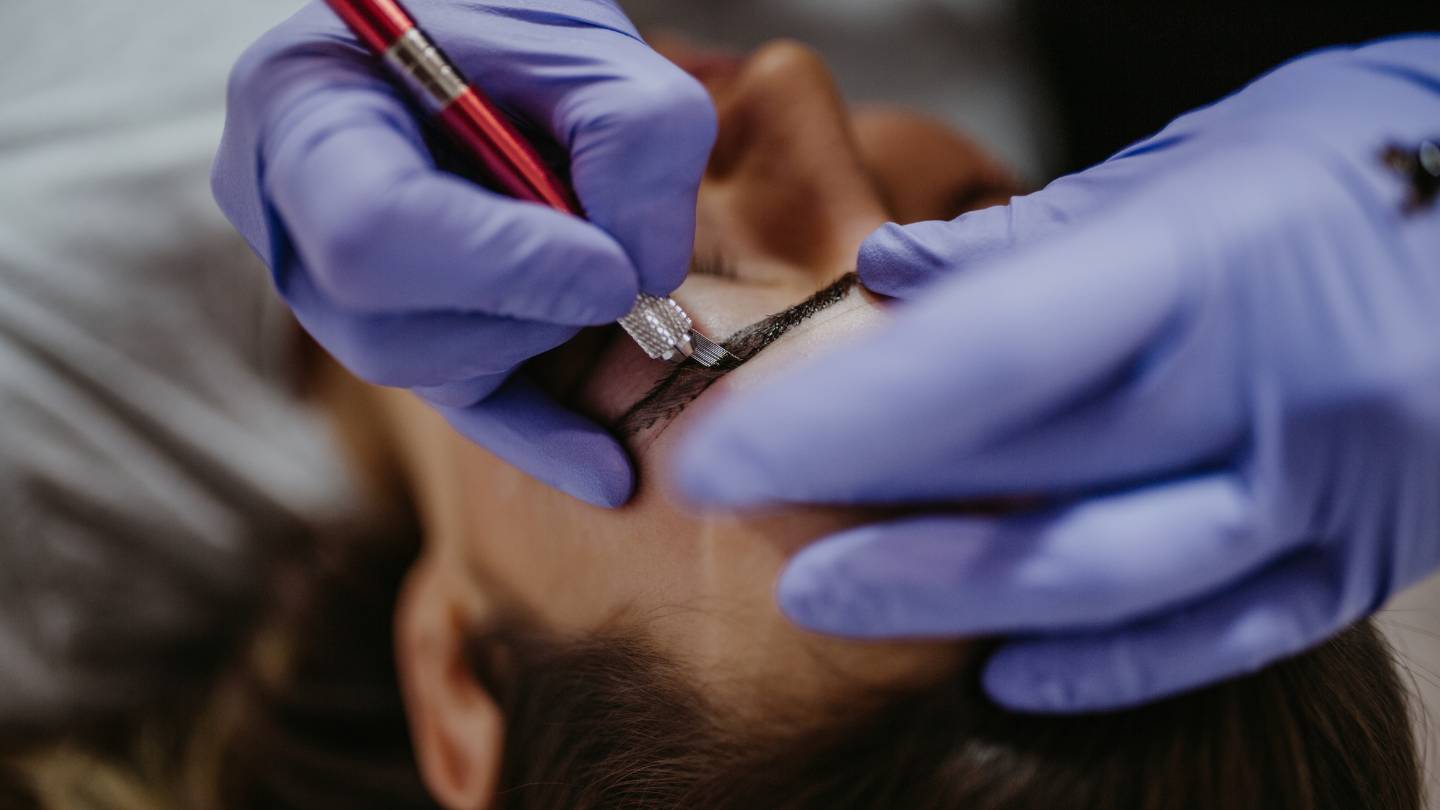Choosing the right eyebrow tattoo technique depends on several factors, but one of the most important is your skin type. Different skin types react differently to eyebrow tattooing methods, affecting both the appearance and longevity of the results.
Whether you have oily, dry, normal, or combination skin, certain eyebrow tattoo techniques will work better for you. Below, we discuss the most common eyebrow tattoo techniques and how they suit various skin types, so you can make an informed decision based on your skin’s characteristics.
Let’s get straight to the point
Choosing the right eyebrow tattoo technique depends on your skin type. Oily skin benefits from powder or combination brows for longer-lasting, smudge-free results, while dry skin retains sharp, natural strokes with microblading.
Combination skin works well with hybrid techniques like combination or powder brows for consistent results across oily and dry areas. Normal skin is versatile and suits most methods, including microblading, powder, or combination brows. Match your skin type with the right technique to achieve the best, long-lasting eyebrow results.
1. Oily Skin
The Challenge Of Oily Skin
If you have oily skin, you might already know that it can cause makeup to fade quickly and lead to smudging. Similarly, eyebrow tattoo pigments tend to break down faster on oily skin because excess oil can push the pigment out, resulting in blurred or faded strokes. Oily skin can also make it harder for the skin to retain sharp, defined lines from techniques like microblading.
Best Techniques For Oily Skin
Powder Brows
Powder brows are the best choice for oily skin. This technique involves the pixelation of pigment into the upper dermal layers, creating a soft, powdery look rather than individual hair strokes. The gradual shading effect ensures that the pigment stays intact for longer periods, even on oily skin. Powder brows also tend to last longer because the shaded look is less affected by the oil that would otherwise cause the hair-like strokes in other methods to blur.
- Advantages for Oily Skin:
- Longer-lasting compared to other techniques.
- Less prone to fading or blurring.
- Offers a fuller, bolder look that suits oily skin.
- Disadvantages:
- Doesn’t provide a natural, hair-like effect.
Combination Brows
Combination brows, also known as hybrid brows, use both microblading and shading techniques. This approach offers natural-looking strokes at the front of the brow, combined with shading throughout the arch and tail for more definition. For oily skin, combination brows are a good option because the shading helps the brows last longer, while the microblading strokes add a realistic, hair-like effect.
- Advantages for Oily Skin:
- Blends natural strokes with shading for better pigment retention.
- Suitable for those wanting both a natural and fuller brow.
- Disadvantages:
- Microblading strokes may still fade faster than the shading part.
Techniques To Avoid
Microblading on its own is not ideal for oily skin. While it offers a natural look, the fine strokes can blur and fade quickly as the oil interferes with pigment retention. Therefore, if you have oily skin, it’s best to avoid relying solely on this method.
2. Dry Skin
The Challenge Of Dry Skin
Dry skin is typically less prone to excess oil, which means it tends to retain eyebrow tattoo pigments more effectively. Pigment usually stays sharper and more vibrant on dry skin for longer periods. However, if not properly moisturised, dry skin can become flaky or cracked, which can affect healing after an eyebrow tattoo procedure.
Best Techniques For Dry Skin
Microblading
Microblading works best on dry skin because the skin’s lack of excess oil allows the fine, hair-like strokes to stay sharp and defined. This technique creates a natural-looking brow, perfect for those with thin or sparse eyebrows. Dry skin also holds onto the pigment better, making microblading last longer without the need for frequent touch-ups.
- Advantages for Dry Skin:
- Sharp, defined hair strokes.
- Provides a natural look.
- Pigment retention is higher, so results last longer.
- Disadvantages:
- May require extra hydration during the healing process.
Feather Brows
Feather brows, like microblading, create ultra-fine hair strokes for a more natural appearance. The difference lies in the technique, where a more detailed approach is used to ensure each stroke mimics the direction and thickness of your natural eyebrow hairs. For dry skin, this technique offers a lifelike appearance that blends seamlessly with the natural brow hair.
- Advantages for Dry Skin:
- Extremely natural-looking results.
- Great for sparse brows needing volume and definition.
- Disadvantages:
- May fade faster than powder techniques on some dry skin types.
Techniques To Avoid
Dry skin types should avoid heavily shaded techniques like powder brows if they prefer a natural look. The powdered effect may appear too bold on naturally dry skin, which doesn’t have the oil to soften the look.
3. Combination Skin
The Challenge Of Combination Skin
Combination skin features both oily and dry patches, typically with an oily T-zone and dry areas around the cheeks or other parts of the face. This can make it tricky to choose the best eyebrow tattoo technique, as different parts of the skin may react differently to the procedure.
Best Techniques For Combination Skin
Combination Brows
Just as the name suggests, combination brows are ideal for combination skin types. This hybrid technique uses microblading at the front of the brow for natural strokes, paired with shading through the arch and tail. This approach provides the best of both worlds, ensuring that the oily parts of the skin retain the shaded areas better, while the hair strokes stay intact on the drier parts.
- Advantages for Combination Skin:
- Versatile approach that suits both dry and oily areas.
- Provides a natural, hair-like look with added definition.
- Disadvantages:
- May still require more frequent touch-ups on oily areas.
Powder Brows
Powder brows are another good option for combination skin. This technique provides a soft, shaded effect that can hold up well in both the oily and dry areas of the skin. It’s especially useful for those with patchy or uneven brows, offering a consistent look throughout the brow.
- Advantages for Combination Skin:
- Long-lasting and well-suited for mixed skin types.
- Offers a consistent look across oily and dry areas.
- Disadvantages:
- May not offer the same natural, hair-like strokes as microblading.
Techniques To Avoid
If you have combination skin, fully microbladed brows might not last as long, especially in the oily areas, where the strokes can blur. A combination of techniques will give better overall results.
4. Normal Skin
The Benefits Of Normal Skin
Normal skin is the most versatile skin type when it comes to eyebrow tattooing. It isn’t too oily or too dry, so it can hold pigment well without excessive fading or blurring. Normal skin types usually don’t face the same challenges as oily or dry skin, meaning most techniques will yield great results.
Best Techniques For Normal Skin
Microblading
For normal skin, microblading offers a natural, hair-like appearance that is easy to maintain. Since normal skin retains pigment well and doesn’t produce too much oil, the results tend to last longer and require fewer touch-ups.
- Advantages for Normal Skin:
- Natural, realistic results.
- Long-lasting without frequent touch-ups.
- Disadvantages:
- May not offer the fuller look some people prefer.
Combination Brows
Combination brows are another excellent choice for normal skin. This method offers the natural look of microblading at the front of the brow, with shading at the tail for added depth and definition. Combination brows are perfect if you want a natural yet bold look.
- Advantages for Normal Skin:
- Best of both worlds: natural hair strokes and definition.
- Suits various styles, from natural to bold.
- Disadvantages:
- Slightly more expensive due to the use of multiple techniques.
Powder Brows
Normal skin can also handle powder brows well. The soft, powdered look adds depth and dimension to the brows, and since normal skin doesn’t produce excess oil, the pigment stays in place without too much fading.
- Advantages for Normal Skin:
- Long-lasting results.
- Gives a soft, yet defined look.
- Disadvantages:
- May appear more “made up” compared to microblading.
Conclusion
Choosing the right eyebrow tattoo technique is essential for achieving the best, most long-lasting results tailored to your skin type. Whether you have oily, dry, combination, or normal skin, understanding how your skin interacts with various methods like microblading, powder brows, or combination brows will help you make an informed decision.
Oily skin types generally benefit from techniques like powder brows, while dry skin retains the sharp strokes of microblading. Combination skin does best with hybrid methods, while normal skin can typically accommodate a wide range of options. By matching your skin type with the most suitable eyebrow tattooing method, you can enjoy beautiful, long-lasting brows that enhance your natural beauty.
FAQs About Eyebrow Tattoo
What Are The Different Types Of Eyebrow Tattoo Techniques Available For Different Skin Types?
The most common eyebrow tattoo techniques suitable for various skin types include microblading, powder, and ombre brows. Microblading is great for those with normal to dry skin, while powder and ombre brows are better for individuals with oily or combination skin.
Can People With Sensitive Skin Get Eyebrow Tattoos?
Yes, individuals with sensitive skin can get eyebrow tattoos. Still, choosing an experienced technician who uses hypoallergenic pigments and takes extra precautions to minimize any potential discomfort or allergic reactions is essential.
How Do I Determine My Skin Type For Choosing The Right Eyebrow Tattoo Method?
You can determine your skin type by observing its characteristics. You likely have oily skin if your skin is oily and prone to shine. Dry skin often feels tight and may have flakiness, while normal skin feels balanced and not overly dry or oily. Combination skin exhibits characteristics of both oily and dry skin. Understanding your skin type will help you select the most suitable eyebrow tattoo technique.
Are There Any Skin Types That Should Avoid Getting Eyebrow Tattoos Altogether?
While most skin types can undergo eyebrow tattooing, those with extremely sensitive or highly reactive skin may want to consult a dermatologist before proceeding. Individuals with certain skin conditions or allergies may not be ideal candidates for eyebrow tattoos.
How Can I Ensure My Eyebrow Tattoo Lasts Longer On My Skin Type?
To extend the longevity of your eyebrow tattoo, follow aftercare instructions carefully, which typically involve avoiding excessive moisture, sun exposure, and harsh skincare products. Regular touch-ups and using a sunscreen specifically designed for tattoos can also help preserve the tattoo’s colour and shape on your unique skin type.


